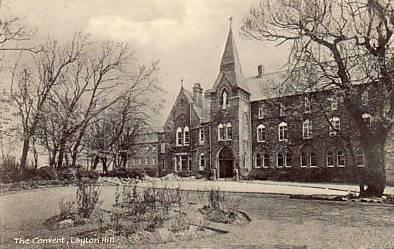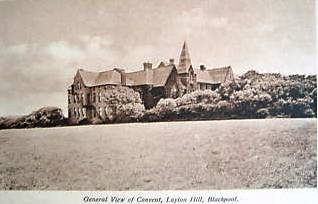|
BLACKPOOL GAZETTE & HERALD—MARCH 3, 1956.
100 YEARS AGO THE CONVENT WAS BORN
THE time is somewhere in the late 1860s; the place Blackpool—population about
3,000. A comparatively peaceful era in the town's history, yet there is a minor uproar among the
parents of young girls under the care of the nuns of the recently-formed Holy Child Order.
The reason for this polite disturbance is the fact that the nuns, under the
guidance of the Mother Foundress, have decided to build a convent. That in itself is praiseworthy,
but the spot chosen is not —Layton Hill, the highest point in the town.
" Too isolated . . . far too exposed . . . it will never succeed," expostulate
the parents, who no doubt feel that the nuns are showing considerable lack of concern over the
young ladies' health. Yet in the face of all this opposition the nuns persevere, the new house
is built, and because of their strength of mind, the Convent of the Holy Child Jesus, Layton
Hill, is able to celebrate its centenary some 85 years later in 1956.

THE START
The new building was not the start of the actual school. That was established
some years earlier, having had its very modest beginnings in 1856 in a small boarding school on the
corner of Queen's-square—certainly a far cry from today's impressive pile. In this tiny school, the
nuns, newly arrived in Blackpool, taught approximately 21 children, and in addition held a class in
the cellar of the Talbot Hotel.
One cannot help comparing that handful of pupils with the 500 girls who throng
the school today—surely proof of the remarkable expansion brought about by high ideals in education
which have been recognised by four generations of parents.
In 1860 the first move was made, to Raikes Hall, then a country mansion around
which eventually grew the famous Blackpool pleasure gardens. Many old prints from those peaceful
days are still to be found in the school, often picturing young girls playing tennis with
antiquated racquets and wearing gowns which would be irksome and severely handicapping to the
young sportswoman of today.
FLOURISHED
By 1870 the original part of the present building was completed and in it both
the religious community and the pupils flourished, despite the gloomy forebodings of the school's
early critics.
A day school was begun in 1924, and was housed for a time in Whinney Heys Hall,
a pre-Reformation mansion said to have provided refuge many times for hunted priests. Local
tradition has it, too, that a tunnel once ran from the hall down to the seaside home of the
Tyldesley family, Foxhall.
In 1928, the convent became a direct-grant grammar school, and in 1934 the first
big extension was made to the buildings in memory of the Mother Foundress of the Order, Cornelia
Connelly.
This was followed by further additions in 1939 and 1950, and most recently in
September last year when a much needed spacious library, a physics laboratory and four large, airy
classrooms were built.
And so to the present day. The once open countryside—so open in fact, that a
member of the Order, Mother Mary Wilfrid, one of the new school's early pupils. can remember the
magnificent view straight down to the sea—is now closely built up.

STATELY TREES
Saplings planted by the Mother Foundress have grown into stately trees flanking
the semi-circular drive, yet the actual face of the school has not changed much since those days
when she encouraged her nuns to make a success of their bold venture.
And a success it certainly has been. Countless old girls return yearly to renew
their bonds of affection for the school whose century of triumph would have been impossible but for
the enterprise and work of those pioneering nuns.
And as a fitting celebration of thanksgiving for this centenary year, a group of old girls,
together with present pupils, will make a pilgrimage to Rome at Easter.
|